
Mercury was a brand of mid-priced automobiles produced by American manufacturer Ford Motor Company between 1938 and 2011 with 1939 being the first model year. It stood as its own line within Ford until 1945, and thereafter formed half of Ford's Lincoln-Mercury Division. The brand was created by Edsel Ford in 1938 to bridge the gap between the Ford and Lincoln model lines.
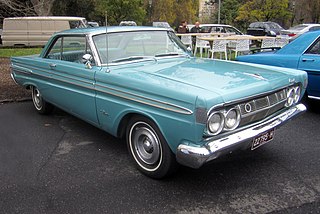
The Mercury Comet is an automobile that was produced by Mercury from 1960–1969 and 1971–1977 — variously as either a compact or an intermediate car. In its first two years, it was marketed as the "Comet" and from 1962 as the "Mercury Comet".

The Mercury Cougar is a series of automobiles that was sold by Mercury from 1967 to 2002. The model line is a diverse series of vehicles; though the Cougar nameplate is most commonly associated with two-door coupes, at various stages in its production, the model also was offered as a convertible and a hatchback. During its production as the mid-size Mercury line, the Cougar was also offered as a four-door sedan and five-door station wagon.
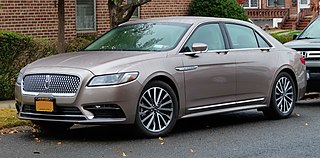
The Lincoln Continental is a series of mid-sized and full-sized luxury cars produced between 1939 and 2020 by Lincoln, a division of the American automaker Ford Motor Company. The model line was introduced following the construction of a personal vehicle for Edsel Ford, who commissioned a coachbuilt 1939 Lincoln-Zephyr convertible, developed as a vacation vehicle to attract potential Lincoln buyers. In what would give the model line its name, the exterior was given European "continental" styling elements, including a rear-mounted spare tire.

The Ford Fairmont is a model line of compact cars that was manufactured by Ford from the 1978 to 1983 model years. The successor of the Ford Maverick, the Fairmont marked the third generation of compact sedans sold by Ford in North America. Initially slotted between the Pinto and Granada within the Ford line, the Fairmont was later marketed between the Ford Escort and Ford LTD. In contrast to its predecessor, the model line was offered as a two-door notchback sedan, two-door coupe, four-door sedan, and five-door station wagon. Though never sold as a Lincoln, Mercury sold a divisional counterpart of the Fairmont as the Mercury Zephyr.

The Ford Fox platform is an automobile platform that was used by Ford Motor Company. Introduced for compact sedans in the 1978 model year, the Fox architecture was utilized for a wide variety of configurations for Ford and Lincoln-Mercury vehicles. In its original form, the platform was used through the 1993 model year; a substantial redesign of the Ford Mustang extended its life into the 21st century, ending production in 2004. Produced across 26 model years, the Fox platform is the second-longest car architecture ever designed by Ford Motor Company.
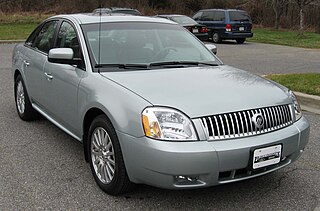
The Mercury Montego is a nameplate that was applied to three separate generations of vehicles marketed by the Mercury division of Ford Motor Company. Taking its name from Montego Bay, Jamaica, the nameplate made its first appearance for 1967 in the Canadian market as part of the Mercury-derived Meteor model line. For 1968, the Mercury Montego made its debut across North America, becoming the Mercury counterpart of the Ford Torino intermediate-size model line for two generations.
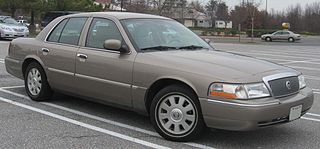
The Mercury Grand Marquis is an automobile that was produced by Mercury from the 1975 until 2011 model years. Introduced as the flagship sub-model of the Mercury Marquis in 1975, the Grand Marquis became a stand-alone model line in 1983, serving as the largest Mercury sedan. The model line served as the sedan counterpart of the Mercury Colony Park station wagon up to 1991. The fourth generation was the basis of the 2003 and 2004 Mercury Marauder.
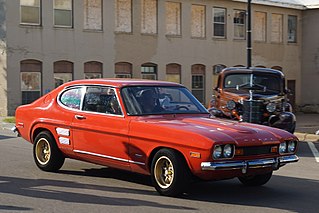
Capri is a nameplate marketed by the Lincoln-Mercury division of Ford Motor Company over three generations between 1970 and 1994.

The Ford LTD is a range of automobiles manufactured by Ford for the 1965 to 1986 model years. Introduced as the highest trim level of the full-size Ford model range, the LTD moved the Ford range upmarket, offering options and features previously reserved for Mercury and Lincoln vehicles. For much of its production life, the LTD competed against the Chevrolet Caprice ; the Mercury Marquis served as its divisional counterpart from 1967 until 1986.

The Lincoln Versailles is a mid-size luxury car that was marketed by Lincoln from the 1977 to 1980 model years. The first Lincoln introduced outside of the full-size segment, the Versailles is a rebranded version of the Ford Granada and Mercury Monarch. Replacing the Mercury Grand Monarch Ghia, the model line was introduced as a competitor to the Cadillac Seville.
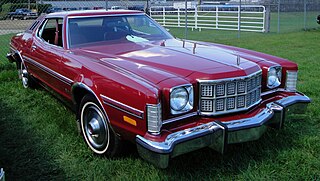
The Ford Elite is a personal luxury car produced by Ford and marketed in North America from February 1974 to 1976, using the name Gran Torino Elite for its first model year only then simplified to just Elite for the following two model years.

The Ford LTD II is an automobile produced and marketed by Ford Motor Company between 1977 and 1979 in the United States and Canada. Deriving its name from the full-sized Ford LTD model line, the intermediate LTD II consolidated the Ford Torino and Gran Torino model lines, with the Ford Elite replaced by the Ford Thunderbird. Offered in a two-door sedan, four-door sedan, and station wagon, the LTD II also served as a basis for the final generation of the Ford Ranchero coupe utility.

The Mercury Marquis is a model line of automobiles marketed by Mercury from 1967 to 1986. Deriving its name from a title of French nobility, the Marquis was introduced as the divisional counterpart of the Ford LTD; four generations of the two model lines were paired through rebranding. Initially slotted as the flagship Mercury full-size range, the Marquis would serve as the basis for the later Mercury Grand Marquis.
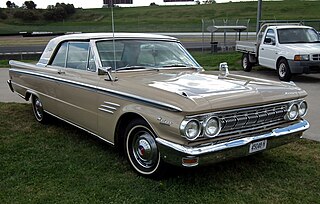
The Mercury Meteor is an automobile that was produced by Mercury from the 1961 to 1963 model years. Adopting its nameplate from the namesake Ford of Canada brand, the Meteor was introduced as the base-trim full-size Mercury sedan, while the compact Mercury Comet shared a naming convention associated with the ongoing Space Race of the early 1960s. Slotted below the Mercury Monterey, the Meteor was the Mercury counterpart of the Ford Fairlane.

The Ford Falcon is a model line of cars that was produced by Ford from the 1960 to 1970 model years. Though preceded by the Rambler American, the Falcon was the first compact car marketed by the Big Three American manufacturers.
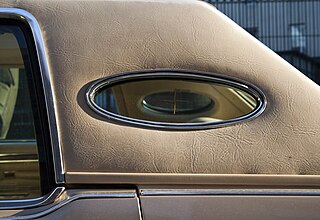
An opera window is a small fixed window usually behind the rear side window of an automobile. They are typically mounted in the C-pillar of some cars. The design feature was popular during the 1970s and early 1980s and adopted by domestic U.S. manufacturers, most often with a vinyl roof.

The Ford Maverick is a compact car manufactured and marketed by Ford for model years 1970–1977 in the United States, originally as a two-door sedan employing a rear-wheel drive platform original to the 1960 Falcon — and subsequently as a four-door sedan on the same platform. The Maverick replaced the Falcon in most of the world, but Australia kept selling and developing the Falcon.

The North American version of the Ford Granada is a range of sedans that was manufactured and marketed by Ford over two generations (1975–1982). Developed as the original successor for the Ford Maverick, the Granada shares its name with Ford of Europe's flagship sedan. The model line was marketed as a luxury compact vehicle, expanding the segment in the United States.
In the context of the automobile industry, downsizing is a practice used to transition vehicles from one size segment to another. Commenced during the Malaise era, downsizing is done in response to consumer and government demands influencing vehicle design. As vehicle product lines completed their model cycles, automobile manufacturers developed the next generation of a vehicle with a smaller exterior footprint to allow for weight reduction and increased fuel economy, using a shortened wheelbase and body length.



























